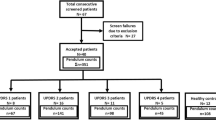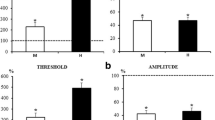Summary
The patellar tendon jerk was examined quantitatively in 8 cases of Huntington's disease and in 27 controls using surface electrodes over the quadriceps femoris and biceps femoris muscles. The purpose was to investigate whether Gordon's patellar phenomenon was caused by a lack of antagonistic innervation or by late agonistic tonic reflex activity in Huntington's disease. Specific results could indicate that the patellar tendon jerk could be used as a diagnostic aid, as is the long loop reflex of hand muscles. A late tonic stretch response was found, appearing between 160 and 260 ms after the tendon tap. This response appeared in 6 out of the 8 Huntington's cases, even when Gordon's phenomenon was not observed. Therefore, it could be assumed that the tonic quadriceps activation gives rise to the clinically observed Gordon's phenomenon.
Similar content being viewed by others
References
Altenburger H (1937) Elektrodiagnostik (einschliesBlich Chronaxie und Aktionsströmen). In: Bumke O, Foerster O (eds) Handbuch der Neurologie, Band 3, Springer, Berlin, pp 747–1086
Bing R (1932) Lehrbuch der Nervenkrankheiten. 4. Auflage, Urban & Schwarzenberg, Berlin, Wien
Brown WF (1984) The physiological and technical basis of electromyography. Butterworth, Boston, London
Bruyn GW (1968) Huntington's chorea. In: Vinken PJ, Bruyn GW (eds) Handbook of clinical neurology, vol. 6, North Holland, Amsterdam
Chan CWY, Melvill Jones G, Kearney RE, Watt DGD (1979) The “late” electromyographic response to limb displacement in man. I. Evidence for supraspinal contribution. Electroencephalogr Clin Neurophysiol 46:173–181
Cody FWJ, McDermott N, Matthews PBC, Richardson HC (1986) Observations on the genesis of the stretch reflex in Parkinson's disease. Brain 109:229–249
Dietz V, Quintern J, Berger W (1985) Afferent control of human stance and gait: evidence for blocking of group I afferents during gait. Exp Brain Res 61:153–163
Eisen A, Burton K, Larsen A, Hoirch M, Calne D (1984) A new indirect method for measuring spinal conduction velocity in man. Electroencephalogr Clin Neurophysiol 59:204–213
Fahrenkamp K (1913) Über die Aktionsströme der menschlichen Skelettmuskulatur bet unwillkiirlicher Kontraktion. Dtsch Z Nervenheilk 47:102–121
Folstein SE, Leigh RJ, Parhad IM, Folstein MF (1986) The diagnosis of Huntington's disease. Neurology (Minn) 36:1279–1283
Gassel MM, Ott KH (1973) pp 308–316 in: Desmedt JE (ed) New developments in electromyography and clinical neurophysiology, vol III. Karger, Basel
Gordon A (1908) Diseases of the nervous system. P Blakiston's Son & Co, Philadelphia
Grinker RR, Bucy PC, Sahs AL (1960) Neurology. Thomas, Springfield, Ill
Hassler R (1953) Extrapyramidal — motorische Syndrome and Erkrankungen. In: Bergmann G, Frey W, Schwiegk H (eds) Handbuch der inneren Medizin, vol 5/3. Springer, Berlin Heidelberg Göttingen, pp 676–904
Henatsch HD (1986) Die motorische Grammatik des Rückenmarks — Bestandaufnahme und Revision. Fortschr Neurol Psychiatr 54:273–288
Meinck HM, Küster S, Benecke R, Conrad B (1985) The flexor reflex — influence of stimulus parameters on the reflex response. Electroencephalogr Clin Neurophysiol 61:287–298
Noth J, Podoll D, Friedemann HH (1985) Long-loop reflexes in small hand muscles studied in normal subjects and in patients with Huntington's disease. Brain 108:65–80
Quintern J, Berger W, Dietz V (1985) Compensatory reactions to gait perturbations in man: short- and long-term effects of neuronal adaptation. Neuroscience Lett 62:371–376
Weerd AW de, Jonkman EJ (1986) Measurement of knee tendon reflex latencies in lumbar radicular syndromes. Eur Neurol 25:304–308
Author information
Authors and Affiliations
Rights and permissions
About this article
Cite this article
Claus, D., Lang, C. & Neundörfer, B. Gordon's reflex phenomenon in huntington's disease. Eur Arch Psychiatr Neurol Sci 236, 303–308 (1987). https://doi.org/10.1007/BF00380957
Received:
Issue Date:
DOI: https://doi.org/10.1007/BF00380957




